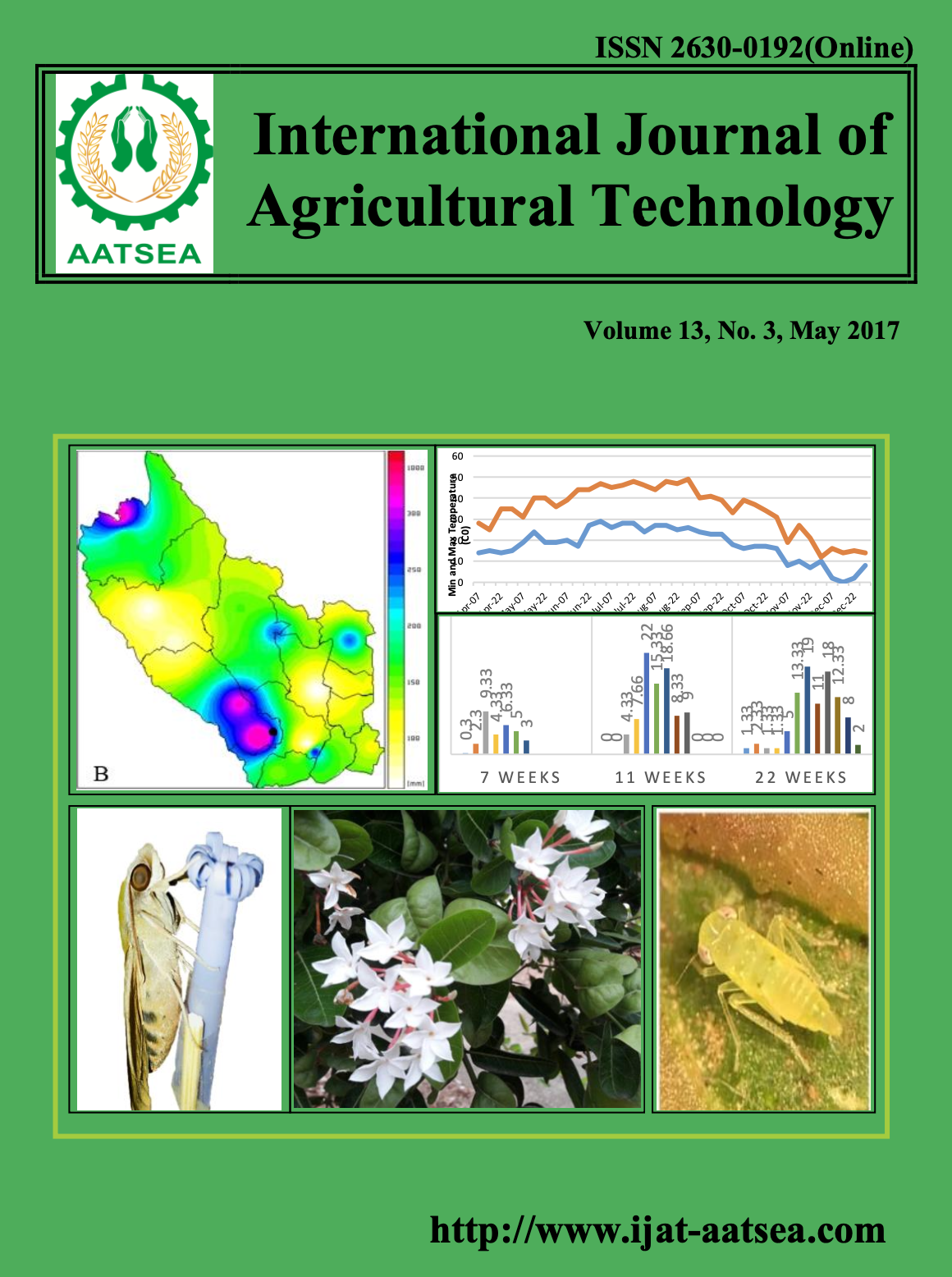The Study of Seasonal and Climate Changes on Macrofungi Biodiversity in the Community Forest at Sai Yok District, Kanchanaburi Province, Thailand
Main Article Content
Abstract
The biodiversity of macrofungi is important for future comparison to understand the fungal biodiversity. This research was performed during dry and wet season in 2016.
Macrofungi were collected and morphological identified according to their macro and microscopic structures. Fifteen species were found including thirteen saprophytic macrofungi and two mycorrhizal mushroom. In addition, the result revealed that seven species (46.66 %) is an edible mushroom. It suggested that these edible mushroom can be consumed in dailylife of local people living in this area, and seasonal and climate changes were directly affected to macrofungi biodiversity.
Article Details

This work is licensed under a Creative Commons Attribution-NonCommercial-NoDerivatives 4.0 International License.
References
Andrew, E. E., Kinge, T. R., Tabi, E. M., Thiobal, N. and Mih, A. M. (2013). Diversity and distribution of macrofungi (mushrooms) in the Mount Cameroon Region. Journal of Ecology and the Natural Environment 5:318-334.
Chansrikul, A., Suwanarit, P., Sangwanit, U., Morinaga, T., Nishizawa, Y. and Murakani, Y. (2008). Diversity of mushroom and macrofungi in Thailand. 1th Edition. Kasetsart University Press. Bangkok.
Cuptapun, Y., Hengsawadi, D., Mesomya, W. and Yaieia, S. (2010). Quality and quantity of protein in certain kinds of edible mushroom in Thailand. Kasetsart Journal (Natural Science) 44:664-670.
Egli, S. (2011). Mycorrhizal mushroom diversity and productivity–an indicator of forest health?. Annals of Forest Science 68:81-88.
Gadd, G, M., Burford, E. P. and Fomina, M. (2003). Biogeochemical activities of microorganisms in mineral transformations: Consequences for metal and nutrient mobility. Journal of Microbiology and Biotechnology 13:323-331.
Gilbertson, R. L. (1980). Wood-rotting fungi of North America. Mycologia 72:1-49.
Karwa, A. and Rai, M. K. (2010). Tapping into the edible fungi biodiversity of Central India. Biodiversitas 11:97-101.
Kauserud, H., Stige, L. C., Vik, J, O., Okland, R. H., Hoiland, K. and Stenseth, N. C. (2008). Mushroom fruiting and climate change. Proceedings of the National Academy of Sciences 105:3811-3814
Kulsantiwong, J., Kaensa, W., Khamprathum, Y. and Pookang, O. (2014). Diversity of edible mushroom in Phu Phra Bat Historical Park, Udon Thani province. Khon Kaen Agriculture Journal 42:166-171.
Manoharachary C, Sridhar, K., Singh, R., Adholeya, A., Suryanarayanan, T. S., Rawat, S. and Johri, B. N. (2005). Fungal biodiversity: distribution, conservation and prospecting of fungi from India. Current Science 89:58-71.
Miller, O. and Miller, H. (2006). North American Mushrooms: a field guide to edible and inedible fungi (Falconguide). Globe Pequot Press. Guilford.
Nuangmek, W., C. Paekum, M. Titayawan and Pitukpol, W. (2015). Biodiversity of mushroom in plant genetic conservation Project under the Royal Initiative of Her Royal Highness Princess Maha Chakri Sirindhorn at University of Phayao. Khon Kaen Agriculture Journal 43:939-943.
Orachaipunlap, K., Suwannasai, N., Whalley, A. J. S., Phosri, C. and Sihanonth, P. (2016). Biological activities of endophytic Xylaria sp. isolated from tropical forest in Chaiyapoom province, Thailand. Biological and Chemical Research 3:200-208.
Pavithra, M., Greeshma, A. A., Karun, N. C. and Sridhar, K. R. (2015). Observations on the Astraeus spp. of Southwestern India. Mycosphere 6:421-432.
Pukahuta, C., Suwanakood, P., Sutthikampa, S. and Unphim, U. (2016). Diversity of mushrooms found in Buddhist forest monastery in Ubon Ratchathani. The 10th Botanical Conference of Thailand: BCT10. Ubon Ratchathani University. Ubon Ratchathani 117-134.
Pushpa, H. and Purushothama, K. B. (2012). Biodiversity of Mushrooms in and Around Bangalore (Karnataka), India. American-Eurasian journal of Agriculture and Environmental Science 12:750-759.
Ryvarden, L. (1991). Genera of polypores, nomenclature and taxonomy. Synopsis Fungorum. 5:1-373.
Sanoamuang, N. (2010). Wild mushrooms of Thailand: biodiversity and utilization. Universal Graphics and Trading Ltd. Bangkok.
Soytong, K. (1994). Mushrooms and Macrofungi in Thailand. Siritham Offset. Bangkok. Thailand.
Sutjaritvorakul, T., Whalley, A. J. S., Sihanonth, P. and Roengsumran, S. (2010). Antimicrobial activity from endophytic fungi isolated from plant leaves in Dipterocarpous forest at Viengsa district Nan province, Thailand. Journal of Agricultural Technology 6:309-315.
Terakunpisut, J., Gajaseni, N. and Hongprayoon, C. (2007). Local knowledge of ethnic groups on termite mushroom conversation at Huai Khayeng, Kanchanaburi, Thailand. BRT Report: Western Thong Pha Phum. 444-449.
Wani, B. A., Bodha, R. H. and Wani, A. H. (2010). Nutritional and medicinal importance of mushrooms. Journal of Medicinal Plants Research. 4:2598-2604.
Wiriya, J., Kavinlertvatana, P. and Lumyong, S. (2014). Effects of different culture media, carbon and nitrogen sources and solid substrates on growth of Termitomyces mushrooms. Chiang Mai Journal of Science 41:542-556.


